- The Agriculture Dictionary
- Agriculture & Nature
- Business & Investment
- Farm Animals
- How To Start
- Innovation & Technology
- Pest Control
- Uncategorized

Agriculture Project Topics | 100 Project Ideas
Are you a student passionate about agriculture and seeking compelling project topics to work on? Look no further! In this article, we will explore a diverse range of agriculture project topics that promise both academic enrichment and practical insights. From sustainable farming practices to innovative technologies shaping the future of agriculture, we’ve got you covered.
Embarking on an agriculture project can be a rewarding experience, providing students with the opportunity to apply theoretical knowledge to real-world challenges. Whether you are majoring in agronomy, agricultural economics, or agribusiness, these project topics are designed to ignite your curiosity and fuel your academic journey.
List of 100 agriculture project topics
We compiled a list of 100 new agriculture project topics you can work on, check them out
- Sustainable Crop Rotation Strategies for Enhanced Soil Health
- Impact of Climate Change on Crop Yields: A Regional Analysis
- Precision Agriculture: Integrating Technology for Farm Management
- Analyzing the Economics of Organic Farming Practices
- Hydroponics vs. Traditional Soil Cultivation: A Comparative Study
- The Role of Biotechnology in Crop Improvement
- Assessing the Effectiveness of Drip Irrigation Systems
- Exploring Vertical Farming as a Solution to Urban Food Security
- Evaluating the Impact of Pesticides on Soil Microbial Diversity
- Adoption of Smart Farming Technologies in Developing Countries
- Sustainable Livestock Farming Practices: A Case Study
- The Economics of Beekeeping for Pollination Services
- Agroforestry Systems: Balancing Agriculture and Conservation
- Analyzing the Role of Women in Agriculture: A Global Perspective
- The Use of Drones in Monitoring Crop Health
- Enhancing Water Use Efficiency in Agriculture
- Evaluating the Potential of Permaculture in Sustainable Agriculture
- Genetically Modified Crops: Benefits and Controversies
- Impact of Land Fragmentation on Agricultural Productivity
- Exploring Aquaponics: Integrating Fish Farming and Crop Cultivation
- Assessing the Social and Economic Impacts of Farmer Cooperatives
- The Role of Agricultural Extension Services in Rural Development
- Utilizing Big Data Analytics for Crop Yield Prediction
- Analyzing the Nutritional Content of Indigenous Crops
- Comparative Analysis of Different Soil Conservation Techniques
- The Future of Agriculture: Trends and Innovations
- Investigating the Impact of Global Trade Policies on Agriculture
- Organic vs. Conventional Farming: A Consumer Preference Study
- Assessing the Viability of Rooftop Farming in Urban Areas
- The Role of Agrochemicals in Modern Agriculture
- Impact of Cover Crops on Weed Suppression and Soil Health
- The Influence of Crop Diversification on Pest Control
- Analyzing the Role of Mycorrhizal Fungi in Enhancing Plant Growth
- Comparative Study of Different Irrigation Techniques in Arid Regions
- Investigating the Potential of Edible Insects as a Sustainable Protein Source
- The Effectiveness of Biological Pest Control Methods in Greenhouse Farming
- Assessing the Ecological Footprint of Livestock Farming Practices
- Examining the Social Dynamics of Farmers’ Markets in Urban Areas
- Exploring the Impact of Agricultural Practices on Biodiversity
- The Use of Blockchain Technology in Supply Chain Management for Agricultural Products
- Analyzing the Impact of COVID-19 on Global Food Supply Chains
- Sustainable Management of Agricultural Residue: A Case Study
- The Adoption of Climate-Smart Agriculture Practices in Developing Countries
- Evaluating the Role of Agroecology in Resilient Food Systems
- The Socioeconomic Impacts of Land Degradation on Rural Communities
- Investigating the Use of CRISPR Technology in Crop Improvement
- Analyzing the Factors Influencing Farmers’ Adoption of Precision Livestock Farming
- The Impact of Agricultural Policies on Smallholder Farmers
- Exploring the Potential of In Vitro Meat Production
- The Role of Artificial Intelligence in Farm Management Decision-Making
- Assessing the Nutritional Quality of Fortified Crops in Addressing Micronutrient Deficiencies
- Comparative Study of Different Fertilization Methods on Crop Productivity
- Investigating the Relationship Between Soil Microbiota and Plant Health
- The Role of Agricultural Cooperatives in Empowering Women Farmers
- Evaluating the Environmental Impact of Genetically Modified Organisms (GMOs)
- Analysis of Food Waste in the Agricultural Supply Chain
- Exploring the Feasibility of Rooftop Aquaculture in Urban Settings
- Assessing the Impact of Land Use Change on Ecosystem Services
- The Use of Remote Sensing in Monitoring Rangeland Health
- Comparative Analysis of Traditional and Modern Rice Cultivation Practices
- Examining the Role of Agri-Tourism in Rural Economic Development
- Analyzing the Impact of Water Scarcity on Agricultural Productivity
- The Role of Agro-Entrepreneurship in Sustainable Agriculture
- Investigating the Potential of Perennial Crops in Carbon Sequestration
- Comparative Study of Different Soil Amendments for Crop Growth
- Assessing the Socioeconomic Factors Affecting Farmers’ Adoption of Conservation Agriculture
- Exploring the Potential of Algae Farming for Sustainable Biofuel Production
- The Impact of Urbanization on Farmland Conversion and Agricultural Sustainability
- Analyzing the Adoption of Smart Irrigation Systems in Precision Agriculture
- Investigating the Use of Nanotechnology in Agriculture for Enhanced Crop Yield
- Assessing the Impact of Land Tenure Systems on Agricultural Development
- The Role of Agro-Meteorological Information in Crop Planning
- Exploring the Potential of Vertical Hydroponic Farming in Urban Spaces
- Analyzing the Impact of Livestock Grazing on Grassland Ecosystems
- Investigating the Use of Indigenous Knowledge in Sustainable Agriculture
- Assessing the Effectiveness of Agricultural Extension Programs in Rural Development
- The Role of Conservation Agriculture in Mitigating Soil Erosion
- Exploring the Impact of Trade Policies on Global Food Security
- Analyzing the Use of CRISPR Technology in Livestock Breeding
- The Effect of Soil Health on Crop Nutrient Content
- Investigating the Role of Agroforestry in Carbon Sequestration
- The Impact of Water Management Practices on Rice Cultivation
- Analyzing the Adoption of Climate-Resilient Crop Varieties
- The Use of Unmanned Aerial Vehicles (UAVs) in Precision Agriculture
- Investigating the Impact of Agrochemical Runoff on Water Quality
- Assessing the Economic Viability of Small-Scale Organic Farming
- Exploring the Potential of Insect Farming for Animal Feed
- The Role of Social Media in Agricultural Knowledge Dissemination
- Analyzing the Impact of Monoculture on Crop Disease Resistance
- The Effect of Temperature Extremes on Crop Yield Variability
- Investigating the Role of Agro-Processing in Adding Value to Agricultural Products
- Assessing the Impact of Urban Agriculture on Local Food Systems
- The Use of Biochar as a Soil Amendment for Sustainable Agriculture
- Analyzing the Impact of Agricultural Practices on Water Conservation
- Exploring the Adoption of Mobile Technology in Agricultural Extension Services
- The Role of Agri-Insurance in Mitigating Risks for Farmers
- Assessing the Impact of Livestock Waste Management Practices
- Investigating the Use of CRISPR Technology in Disease-Resistant Crops
- Analyzing the Potential of Recycled Water in Agricultural Irrigation
- The Role of Farmer Field Schools in Promoting Sustainable Agriculture
These diverse project topics aim to cater to students with varied interests within the field of agriculture, ensuring an engaging and intellectually stimulating experience. Whether you are fascinated by sustainable practices, cutting-edge technologies, or the socioeconomic aspects of agriculture, there’s a project topic here for you.
Leave a Reply Cancel reply
Your email address will not be published. Required fields are marked *
Save my name, email, and website in this browser for the next time I comment.
Notify me of follow-up comments by email.
Notify me of new posts by email.
Related News
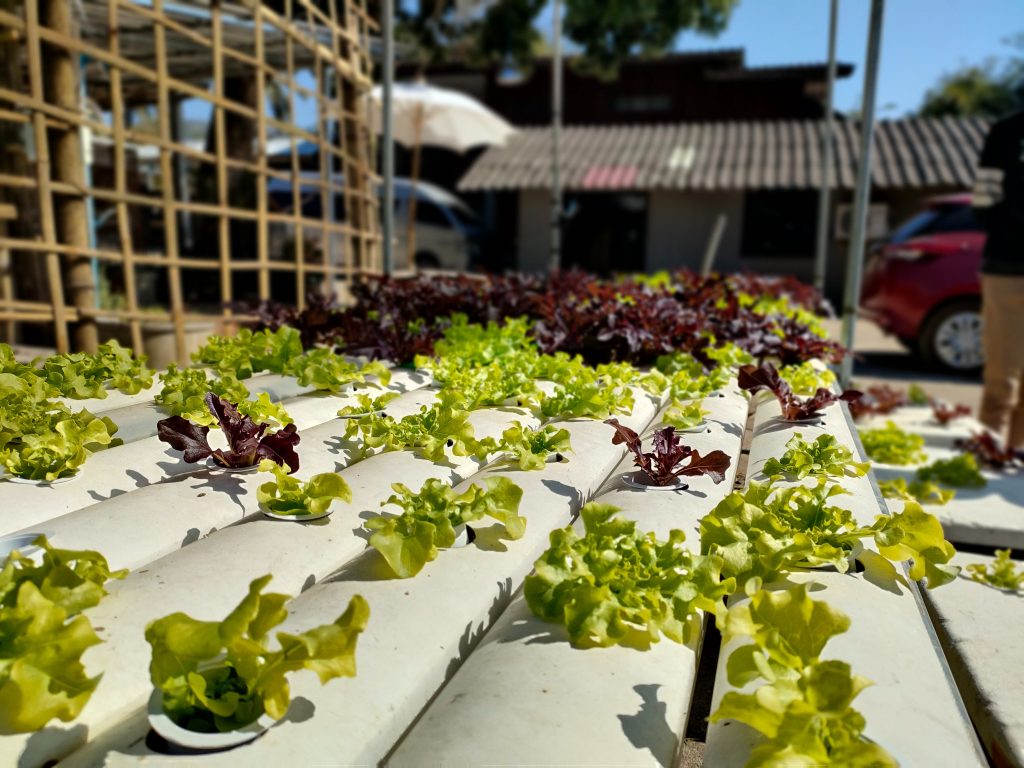
How to Make Nutrient Solution for Hydroponics
Msavi vegetation index | application in eosda crop monitoring.
- Privacy Policy
Latest Projects

- Electronics
- _Automation
- __Automation
- _Microcontroller
Post Top Ad
Jan 29, 2023
25 agriculture projects for students.

List of 40 Agriculture Projects for Students
Conclusion:.
Advertisements:-
About Admin
No comments:
Post a comment, ad post below, author details.
- facebook count=21k; Followers
- twitter count=172; Followers
- rss count=35.1k; Followers
Civil Projects
Mech projects, contact form.

Connect With us
Over 100,000+ Readers Get fresh content from our blog monthly.
5 Key Issues in Agriculture in 2021
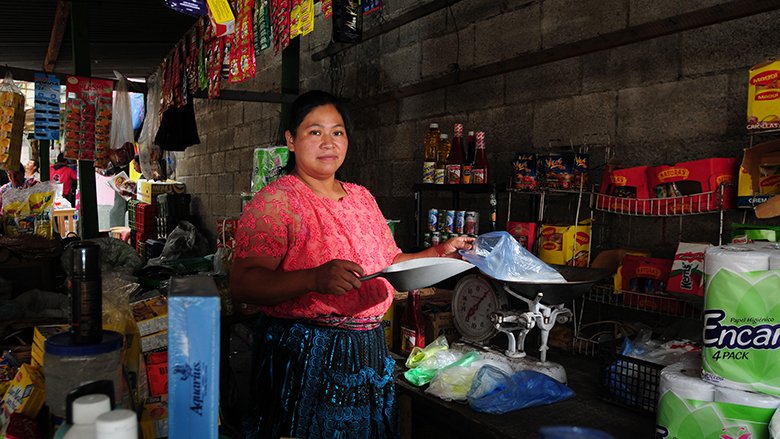
Photo Credit: Maria Fleischmann/World Bank
As 2021 ends, we take a retrospective look at five topics that were covered in our analytical work this year. These issues represent just a fragment of the Bank's work, but they are key to reducing poverty and hunger while slowing climate change.
Food Security
Like the previous year, news in agriculture and food in 2021 was dominated by deteriorating food security. Approximately 30 percent of the world’s population lacked access to adequate food in 2020 and into 2021.
The World Bank took action to fight food insecurity around the world, providing immediate aid to vulnerable households and more long-term support to farmers in the form of seeds, fertilizer, and other agricultural inputs.
COVID-19 also pushed more people into poverty and made the poor poorer around the world. This, along with supply chain interruptions and rising prices had a major impact on hunger. To learn more about these impacts, read this brief compiled by the Bank and updated at least once a month.
Our new podcast series, Table for 10 Billion , launched in March examined the causes of growing hunger and offered some surprising answers.
Farming Insects for Food and Feed
This December, the Bank released a ground-breaking report looking at the valuable role farming insects can play in both food security and climate-smart agriculture, Insect and Hydroponic Farming in Africa: The New Circular Food Economy .
While two billion people regularly eat insects harvested in the wild, farming them for food at scale is new. The report found that African insect farming could generate crude protein worth up to US$2.6 billion and biofertilizers worth up to US$19.4 billion. That is enough protein meal to meet up to 14% of the crude protein needed to rear all the pigs, goats, fish, and chickens in Africa.
Key benefits of insect farming include:
- Insects can be farmed without arable land.
- Insects can be grown within a couple of weeks.
- The food they need to grow comes from food waste.
- Insect waste can be used as fertilizer.
- Insects can be used as animal feed, cutting farmer expenses, and reducing greenhouse gases generated from farming and transporting other feed such as soybeans.
- People can eat insects or sell them for income, increasing food security.
For more on farming insects and the role they can play in the food system, take a listen to this episode of the Table for 10 Billion podcast .
Fixing Food Finance to Build a Greener Future
While agriculture currently accounts for about 25% of greenhouse gas emissions, it also offers opportunities to both fight climate change and feed more people as the world’s population grows to 10 billion people by 2050. One of the keys will be changing the way agriculture is financed and incentivized .
A report from the Bank, published in September, explains the US$12 trillion in annual hidden social, economic, and environmental costs generated by our current food system and offers recommendations to break the cycle by implementing five food finance imperatives that will help implement climate-smart agriculture .
The report, Food Finance Architecture: Financing a Healthy, Equitable and Sustainable Food System , was written in conjunction with the Food and Land Use Coalition, and the International Food Policy Research Institute, and released to coincide with the UN Food Systems Summit.
A feature story and episode of the Table for 10 Billion podcast examine transforming the food system to adapt to climate change.
Digital Agriculture and the Path to the Future
Agriculture continued its march to the digital future in 2021, both with new techniques being developed for growing food and technology that better links the world’s 570 million farmers and 8 billion consumers.
In March, the Bank released the report What’s Cooking: Digital Transformation of the Agrifood System , which explores how digital technologies are improving the food system and provides a roadmap for countries to scale up their own digital agriculture. The report also provides a framework to evaluate policy proposals that can make the food system more efficient, equitable, and environmentally sustainable.
A live event was held in conjunction with the report’s release and the Table for 10 Billion podcast also looked forward to the digital future of food.
Feeding Growing Cities
In March, the Bank looked at the fast-growing cities of Asia and how they have integrated food systems into their planning. The resulting report, RICH Food, Smart City , demonstrated that more needs to be done at the planning stages to ensure a plentiful and safe supply of food to residents now and in the future.
Only 8% of the 170 emerging Asian cities surveyed by the Bank and FAO were deemed to be “food-smart”–working proactively to ensure strong food systems.
As was made clear by the disruptions caused by the COVID-19 pandemic, it is key for cities to pursue “smarter” food policy in order to foster reliable, inclusive, competitive, and healthy (“RICH”) food systems better aligned with their challenges and aspirations.
The authors of the book sat down to answer questions on what needs to be done and how to do it.
This site uses cookies to optimize functionality and give you the best possible experience. If you continue to navigate this website beyond this page, cookies will be placed on your browser. To learn more about cookies, click here .
An official website of the United States government
Official websites use .gov A .gov website belongs to an official government organization in the United States.
Secure .gov websites use HTTPS A lock ( Lock A locked padlock ) or https:// means you’ve safely connected to the .gov website. Share sensitive information only on official, secure websites.
USDA Makes $1.5 Billion Available to Help Farmers Advance Conservation and Climate-Smart Agriculture as Part of President Biden’s Investing in America Agenda
Funding from the Inflation Reduction Act will help farmers save money, create new revenue streams, enhance natural resources, and tackle the climate crisis
MANKATO, Minn., April 3, 2024 – Agriculture Secretary Tom Vilsack today announced the availability of an historic $1.5 billion in fiscal year 2024 to invest in partner-driven conservation and climate solutions through the Regional Conservation Partnership Program (RCPP) as part of President Biden’s Investing in America agenda. The U.S. Department of Agriculture (USDA) is accepting project proposals now through July 2, 2024, that will help farmers, ranchers, and forest landowners adopt and expand conservation strategies to enhance natural resources while tackling the climate crisis. These projects in turn can save farmers money, create new revenue streams, and increase productivity.
The investments in climate-smart agriculture that USDA has made since the beginning of the Biden-Harris Administration, and will continue to make through the Inflation Reduction Act and Partnerships for Climate-Smart Commodities , are estimated to support over 180,000 farms and over 225 million acres in the next 5 years.
Today’s investment is made available through the Farm Bill and the Inflation Reduction Act, the largest climate investment in history, which has enabled USDA’s Natural Resources Conservation Service (NRCS) to boost funding for RCPP. Additionally, NRCS is announcing progress on its effort to streamline and simplify RCPP and improve processes and implementation.
“We had unprecedented demand for the Regional Conservation Partnership Program last year, showing the robust interest in conservation from farmers and ranchers,” Secretary Vilsack said. “Through the increase in funding from President Biden’s Inflation Reduction Act, we’re able to invest even more this year in this important program, increasing our impact across the landscape. We’re looking forward to seeing what the more streamlined and customer-oriented Regional Conservation Partnership Program can do to get more conservation on the ground in the coming months and years.”
There are two separate funding opportunities being announced today: RCPP Classic and RCPP Alternative Funding Arrangements (AFA). RCPP Classic projects are implemented using NRCS contracts and easements with producers, landowners and communities in collaboration with project partners. Through RCPP AFA, the lead partner works directly with agricultural producers to support the development of innovative conservation approaches that would not otherwise be available under RCPP Classic. NRCS will set aside $100 million for Tribal-led projects to be used between both funding opportunities.
The 2024 RCPP funding priorities are climate-smart agriculture, urban agriculture, conservation, and environmental justice. This funding advances President Biden’s Justice40 Initiative , which aims to ensure that 40 percent of the overall benefits of certain climate, clean energy, and other federal investments flow to disadvantaged communities marginalized by underinvestment and overburdened by pollution. Today’s action also advances President Biden’s America the Beautiful initiative, a 10-year, locally led and nationally scaled conservation initiative that includes the voluntary efforts of farmers, ranchers and private landowners.
NRCS encourages proposals led by historically underserved entities or Indian tribes.
Project proposals for RCPP are being accepted through the RCPP portal . Details on the RCPP Classic and RCPP AFA funding opportunities are available on Grants.gov.
NRCS will be hosting webinars to provide additional information. Learn how to participate at the RCPP website .
More about RCPP
RCPP is a partner-driven approach to conservation that funds solutions to natural resource challenges on agricultural land. By leveraging collective resources and collaborating on common goals, RCPP demonstrates the power of public-private partnerships in delivering results for agriculture and conservation.
In November 2023, NRCS announced more than $1 billion for 81 RCPP projects across the country. View the interactive map of awarded projects here .
Since the beginning of the Biden-Harris Administration, NRCS has invested a total of $1.8 billion in 256 RCPP projects covering 49 states and territories.
More about the RCPP Improvement Effort
Through a concerted effort in 2023 using feedback and expertise from partners, employees, leadership and stakeholders, NRCS identified several improvements to RCPP that the agency has implemented and will continue to implement in the months and years ahead. In fiscal year 2024, NRCS is:
- Streamlining RCPP agreement negotiation to allow simultaneous execution of program partnership and supplemental agreements;
- Updating policy and business tools to streamline the development of RCPP agreement deliverables and reducing the need for nationally approved waivers;
- Conducting annual comprehensive training for state program managers and support staff; and
- Delegating additional authority to State Conservationists to support locally led projects.
NRCS will continue to invest in creating a new business tool to support greater automation of RCPP agreement development, obligating funding to partners, and quicker processing of payments.
NRCS is working on model easement deeds to streamline implementation of RCPP easements that use common deed terms for specific land uses.
This year, NRCS aims to reduce negotiation time from 15 months to 6 months, with the goal to reduce the time even further in future years.
For the full list of RCPP improvements NRCS has identified, please visit our website .
In addition to improving RCPP, NRCS is also working to make improvements to its Agricultural Conservation Easement Program and Conservation Stewardship Program to make them function better for producers, partners and staff.
More about the Inflation Reduction Act
These two RCPP funding opportunities include Farm Bill and Inflation Reduction Act funds.
In total, the Inflation Reduction Act provides $19.5 billion over five years to support USDA’s oversubscribed conservation programs, including $4.95 billion for RCPP over five years. The Inflation Reduction Act, part of President Biden’s Investing in America agenda, represents the single largest investment in climate and clean energy solutions in American history. Learn more about NRCS’ Inflation Reduction Act investments in fiscal year 2023 .
USDA touches the lives of all Americans each day in so many positive ways. In the Biden-Harris administration, USDA is transforming America’s food system with a greater focus on more resilient local and regional food production, fairer markets for all producers, ensuring access to safe, healthy and nutritious food in all communities, building new markets and streams of income for farmers and producers using climate smart food and forestry practices, making historic investments in infrastructure and clean energy capabilities in rural America, and committing to equity across the Department by removing systemic barriers and building a workforce more representative of America. To learn more, visit www.usda.gov .
USDA is an equal opportunity provider, employer, and lender.

Sustainable Agriculture: The Future of Farming

“Sustainability” is a buzzword with a variety of meanings. When it comes to sustainable agriculture, the definition seems simple: provide nutritious food for human consumption while utilizing farming practices that preserve natural resources and protect the environment. The UN projects that the global population will reach about ten million by 2050 , so it is becoming increasingly important to moderate the consumption of our resources to ensure that the earth can support the growing population for years to come.

In 2019, agriculture accounted for 10% of the United State’s total greenhouse gas emissions. Additionally, deforestation, which often occurs to clear space for livestock grazing and farming, was responsible for another 10% of total greenhouse gas emissions.
In the last century, the number of farms in the United States has decreased dramatically and the average size of farms has increased, a product of the agriculture industry’s shift towards large-scale factory farms. This diminished the number of family-owned farms as large corporations began to produce the majority of food in America. This shift towards large-scale agriculture has had a myriad of negative effects, such as topsoil depletion, groundwater contamination, degradation of rural communities, harmful conditions for farmworkers, and increased production costs. Sustainable agricultural practices seek to address these issues, ultimately improving both labor conditions for farmworkers and farming’s impact on the environment.
Sustainable agriculture is a dynamic practice that encompasses technology and farming methods to preserve natural resources and ensure their viability for years to come. Some commonly used sustainable agriculture practices include:
- Increased crop diversity: This allows farmers to profit from high yields of multiple crops year round, limit reliance on chemical pesticides, and enhance soil fertility.
- Planting cover crops: Cover crops are planted to protect soil from erosion and provide it with nutrients between growing seasons. They can also be used for livestock grazing, and are effective in limiting pesticide runoff and adding organic matter to soil.
- Hydroponics and aquaponics : These farming practices grow crops without soil so that they can be grown inside or outside in areas with limited space.
- Use of renewable energy sources: Harnessing energy sources like solar, hydroelectric, or wind limits dependence on nonrenewable energy.
- No-till farming: Tilling turns over the top layer of soil before planting new crops, which erodes the soil and kills microbes essential for soil health. No-till farming maintains soil structure and quality for multiple growing seasons.
These are just a few examples of the many sustainable agriculture practices that farmers are implementing around the world to preserve our natural resources and provide nutritious food for the global population. About two million people on Earth are currently experiencing moderate to severe levels of food insecurity, and if current agricultural practices do not shift towards sustainable farming, this number will only increase with the growing population. Sustainable agriculture will allow the planet to thrive while simultaneously supplying healthy food for humans.
To learn more about a farm using sustainable practices, check out our Faces of Farmlink profile on Pierre Sleiman Jr ., founder and CEO of GoGreen Agriculture.
Lauren graduated from Chapman University in May 2020 with a degree in Environmental Science and Policy and joined The Farmlink Project in September 2020. In addition to writing for the newsletter, she is also on a sustainability and carbon credits team. She is originally from Orange County, California, and is currently located in Boston. She is passionate about the environment and leaving the planet better than we found it. Lauren loves hiking and swimming and her favorite produce is butternut squash!
Related Posts

Subscribe to our Newsletter
Get to know us, get involved.
© 2023 | The Farmlink Project P. O. Box 744772 Los Angeles, CA 90074-4772 | The Farmlink Project is a registered 501(c)(3) non-profit; all donations are tax-deductible through our Tax ID/EIN #85-1398171. | Privacy Policy

An official website of the United States government
Here’s how you know
Official websites use .gov A .gov website belongs to an official government organization in the United States.
Secure .gov websites use HTTPS A lock ( Lock A locked padlock ) or https:// means you’ve safely connected to the .gov website. Share sensitive information only on official, secure websites.
USDA Funds Six International Research Projects on Climate-Smart Agriculture
WASHINGTON, Sept. 19, 2022 – The U.S. Department of Agriculture’s Foreign Agricultural Service is awarding $300,000 to six U.S. universities – including three minority-serving institutions – for research and educational partnerships focused on climate-smart agriculture in tropical countries, FAS Administrator Daniel Whitley announced today.
FAS is awarding the funds under the Scientific Cooperation Research Program (SCRP) .
“This year’s SCRP is explicitly focused on helping agriculture adapt to, and mitigate its impacts on, our changing climate,” Whitley said. “We are pairing some of the United States’ top research institutions and scientists with their counterparts from countries where agriculture is particularly vulnerable to the effects of climate change. We’re confident that they can collaborate on climate solutions that contribute to food security and agricultural sustainability, both locally and globally.”
FAS is awarding approximately $50,000 each to:
- Tennessee State University for a project in Nepal
- University of Hawaii at Manoa for a project in Vietnam
- Texas State University for a project in Mexico
- University of Missouri for a project in India
- University of Nebraska for a project in Paraguay
- Louisiana State University for a project in Malaysia
Whitley noted that this year’s SCRP awards support two of USDA’s top priorities under Agriculture Secretary Tom Vilsack and Deputy Secretary Jewel Bronaugh: putting agriculture at the center of solutions to the global climate crisis; and advancing racial justice, equity and opportunity in USDA program administration through the involvement of three prominent minority-serving institutions.
Since the SCRP was established in 1980, USDA has sponsored more than 400 projects in nearly 100 partner countries. The program supports applied research, extension and education projects that create practical solutions to challenges faced by farmers around the globe.
USDA is an equal opportunity provider, employer, and lender.
Related News
Usda trade and foreign agricultural affairs under secretary taylor launches trade mission in south korea, usda secures market access for u.s. poultry exports to colombia, usda trade mission builds new opportunities for u.s. agribusinesses in south korea, get reports, news, and more delivered straight to your inbox.

An official website of the United States government
Here's how you know
The .gov means it’s official. Federal government websites often end in .gov or .mil. Before sharing sensitive information, make sure you’re on a federal government site.
The site is secure. The https:// ensures that you are connecting to the official website and that any information you provide is encrypted and transmitted securely.
About Grants
The lifecycle of grants and cooperative agreements consists of four phases: Pre-Award, Award, Post-Award, and Close Out.
Access to Data
The National Institute of Food and Agriculture is committed to serving its stakeholders, Congress, and the public by using new technologies to advance greater openness.
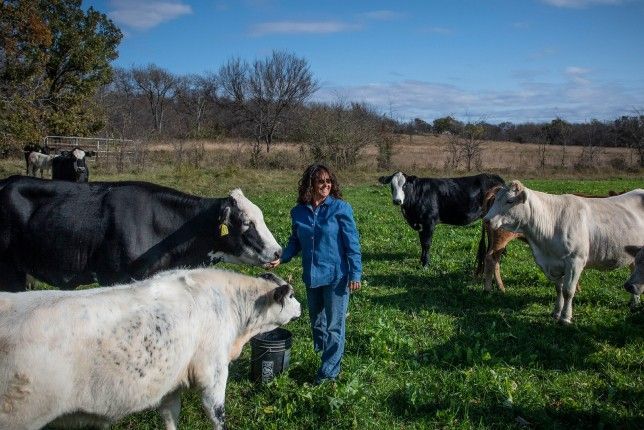
Access Data Gateway
The Data Gateway enables users to find funding data, metrics, and information about research, education, and extension projects that have received grant awards from NIFA.
View Resources Page
This website houses a large volume of supporting materials. In this section, you can search the wide range of documents, videos, and other resources.

Featured Webinar
Second annual virtual grants support technical assistance workshop.
Check out this five-day workshop in March 2024 workshop, designed to help you learn about NIFA grants and resources for grants development and management.
The National Institute of Food and Agriculture provides leadership and funding for programs that advance agriculture-related sciences.

Cultivating the Future: Agricultural Innovations for Climate Resilience
As the world grapples with the impacts of climate change, extreme temperatures and tragic weather events tend to dominate the news. But a slower moving, less conspicuous threat looms in our future: the challenge of maintaining a sustainable, resilient agricultural system.
Supported in part by funding from USDA’s National Institute of Food and Agriculture as well as funding from other federal agencies, the University of Maryland College of Agriculture and Natural Resources’ (AGNR) research and Extension programs take a comprehensive, multi-disciplinary approach to that challenge.
“Climate smart agricultural practices that reduce environmental impact while also building system resilience will ensure that we maintain productive agricultural and forestry systems,” said Dr. Rachel Melnick, division director for Global Climate Change in NIFA’s Institute of Bioenergy, Climate and Environment. “The work highlighted by the University of Maryland are some excellent examples of how Land-grant Institutions are addressing the climate crisis.”
This following article was published by the University of Maryland College of Agriculture and is reprinted here with permission.
Slowing the Burn
According to the Environmental Protection Agency, agriculture of all forms accounts for approximately 10-11% of the total U.S. contribution to the greenhouse gasses that are heating Earth’s atmosphere. Finding ways to reduce emissions from agriculture while maintaining, and even increasing, yields is crucial to helping slow the warming process.
With over $1 million in funding from NASA, Associate Professor Stephanie Yarwood is leading an effort to use satellite data in unraveling the complex relationship between farming practices and nitrogen emissions. The primary contributors to greenhouse gasses from farmland0 are nitrogen compounds from animal waste and fertilizers. But the effects of different farming practices on nitrogen loss from farms, at various times and under diverse conditions, remains unclear. Yarwood’s project uses satellite data to identify “hot spots” and “hot moments” in time, when nitrogen compound levels rise in the atmosphere above farmlands. Her team will then examine the soil microbes to determine how they control the amount and kind of nitrogen released into the air and water, and the effect of various conservation practices on those processes.
“As a microbial ecologist who often thinks in scales no bigger than a shovel full of soil, it is exciting to be working with collaborators using satellites to think at much larger scales and understand these large, atmospheric effects,” Yarwood said.
The team’s ultimate goal is to create models to guide policymakers and stakeholders in reducing nitrogen emissions through climate-smart farming.
Meanwhile, Professor Richard Kohn is tackling farm emissions from another angle. Kohn is studying exactly how metabolism works in the guts of cattle, which burp up methane and account for nearly half of U.S. agriculture’s contribution to greenhouse gas.
Kohn’s lab has looked at alternative feeds, like algae that is purported to reduce methane from cows. But algae may just shift the composition of cow’s waste products away from methane to toxic compounds that are harmful to the cows and the environment. Kohn and his colleagues are evaluating different algae supplements to see if they can help cows produce less waste overall and convert more food to muscle, or meat.
“The goal is ultimately to feed cattle better, so we decrease methane emissions and at the same time make digestion more efficient,” Kohn said.
Adapting To Change
Already feeling the impacts of climate change, many farmers need help adapting to unpredictable conditions now, as well as in the future, because climate change not only brings new temperature and moisture levels, but it allows pests and diseases to spread into new territories. Researcher Chris Walsh began thinking about that decades ago. Now, through years of careful crossbreeding, he has developed two new breeds of apples that address a growing suite of problems for apple growers. His apples are heat-tolerant, blight-resistant, low-maintenance, and delicious-tasting.
While orchard fruits play a significant role in the world’s economy and diet, wheat and corn fill the nation’s granaries and provide a significant portion of the world’s calories. Both are facing environmental threats around the world.
After thousands of years of breeding for large grains and high yields, modern wheat lacks the genetic diversity essential to adapt to those emerging threats. Fortunately, an international team led by Professor Vijay Tiwari has sequenced the complete genome of an ancient variety of wheat known as einkorn. This breakthrough allows researchers to identify genetic traits like disease- and drought-tolerance, and potentially reintroduce those resilience genes into modern bread wheat.
When It’s Time to Pivot
Even with adapted crops and more efficient growing methods, there are places where change has already happened too fast to continue supporting crops. Across the globe, sea level is rising, and in the mid-Atlantic region, land is also sinking due to large geological shifts caused by climate change. The result is that saltwater intrudes into surface and groundwaters in low-lying areas, making the soils too salty for farming.
Alongside collaborators at University of Delaware and George Washington University, AGNR researchers Kate Tully and Rebecca Epanchin-Neil recently found that the area covered by visible salt patches on Delaware, Maryland and Virginia farmland nearly doubled from 2011 to 2019.
They estimated economic losses from the salt patches to be over $427,000, and what’s more, high salinity soils within 200 meters of salt patches accounted for an estimated crop loss of between $39-70 million annually. This is an especially acute problem for corn farmers, because corn is not very salt tolerant, yet it makes up a substantial portion of the crops grown in the region.
“Saltwater intrusion often happens in advance of sea level rise,” said Associate Professor Tully. “This research is the first visualization of this often-invisible symptom of climate change.”
Epanchin-Niell, also an associate professor, said their study can “help identify high risk areas and better target resources and support to regions where transitions are occurring.”
A Grassroots Solution
In the meantime, finding crops that can withstand salty soils could help keep agricultural lands profitable. And AGNR Extension agents are helping with that. Sarah Hirsh and Haley Sater just completed a two-year experiment planting Giant Miscanthus in fields belonging to a soy farmer who had three consecutive years of failed crops. Miscanthus is a tall, perennial grass that is often used for bedding in poultry operations, but it could be marketed for other animals, and for making paper and biofuels.
“Our experimental plots yielded successful harvests,” said Sater, “suggesting this could be an alternative crop that is easy-growing and low-maintenance.”
As a perennial, miscanthus doesn’t need replanting, and once it gets established, it outcompetes weeds and isn’t eaten by deer.
It sounds like a perfect solution, but of course, there is no silver bullet to solving the diverse and complex problems brought on by climate change. Miscanthus is just one tool among many that can help farmers stay profitable and sustainable. Whether it’s through a new view of satellite data, innovative cattle feed, genetically informed breeding, or a host of other initiatives, AGNR is helping pave the way for a resilient and adaptable agricultural future.
Latest Updates
- Latest Funding Opportunities
- Latest Blogs
- Latest Impacts
funding opportunity
Research facilities act program, agriculture and food research initiative - education and workforce development, agriculture and food research initiative - sustainable agricultural systems, nifa publishes report on veterinary medicine loan repayment program, helpful hints to understanding nifa’s funding opportunities, nevada researcher aims to improve sorghum hybrids for dairy cattle feed, grupo de mujeres provides education, community for spanish-speaking women, your feedback is important to us..
New Perspectives on Agricultural Economics, 2022-2026
The proposed initiative will involve four distinct research projects on different topics in agricultural economics. The topics will be selected each year on the basis of interests of ERS staff and some bearing on emerging or current policy issues. NBER research does not make policy recommendations, but provides background information and analysis that can inform policy decisions.
The proposed topic for the 2023 project is “Assessing the Distributional Impacts of Climate Change in the Agricultural Sector.” Climate change affects all aspects of the agricultural sector, from the production of food and fiber, through the choice of technology by producers, to the set of products that are available to consumers and the prices of those products. USDA is committed to understanding the consequences of climate change, as well as the impact of potential policy responses. Economic research on climate-related issues can advance this mission.
The 2023 project will focus on distributional impacts, because USDA is also committed to promoting equitable outcomes both in the impact of climate-related changes and in the design of policy responses. Doing so requires analysis and measurement of the effects of climate change in the agricultural sector on different groups in the population. These include producers and consumers, households in different income groups, racial and ethnic groups, those who live in different areas, and groups defined along other dimensions.
Investigator
Supported by the us department of agriculture grant #59-1000-2-0076, more from nber.
In addition to working papers , the NBER disseminates affiliates’ latest findings through a range of free periodicals — the NBER Reporter , the NBER Digest , the Bulletin on Retirement and Disability , the Bulletin on Health , and the Bulletin on Entrepreneurship — as well as online conference reports , video lectures , and interviews .

- News & Events
- Eastern and Southern Africa
- Eastern Europe and Central Asia
- Mediterranean
- Mexico, Central America and the Caribbean
- North America
- South America
- West and Central Africa
- IUCN Academy
- IUCN Contributions for Nature
- IUCN Library
- IUCN Red List of Threatened Species TM
- IUCN Green List of Protected and Conserved Areas
- IUCN World Heritage Outlook
- IUCN Leaders Forum
- Protected Planet
- Union Portal (login required)
- IUCN Engage (login required)
- Commission portal (login required)
Data, analysis, convening and action.
- Open Project Portal
- SCIENCE-LED APPROACH
- INFORMING POLICY
- SUPPORTING CONSERVATION ACTION
- GEF AND GCF IMPLEMENTATION
- IUCN CONVENING
- IUCN ACADEMY
The world’s largest and most diverse environmental network.
CORE COMPONENTS
- Expert Commissions
- Secretariat and Director General
- IUCN Council

- IUCN WORLD CONSERVATION CONGRESS
- REGIONAL CONSERVATION FORA
- CONTRIBUTIONS FOR NATURE
- IUCN ENGAGE (LOGIN REQUIRED)
IUCN tools, publications and other resources.
Get involved
Agriculture and soil biodiversity
Agriculture is a vital human activity that deeply impacts, but also deeply relies on nature.
Agriculture is expected to cover an increasing world food, feed, fiber and fuel demand for 8.5 billion people in 2030.
The shift to more sustainable production systems and agricultural practices is therefore critical to conserve nature and achieve more sustainable and resilient societies.
IUCN engagement in agriculture and soil biodiversity
IUCN has developed a new engagement in agriculture, guided by the vision of a future where biodiversity is restored and conserved on farms and in agricultural landscapes as nature-based solutions to global challenges and human and societal needs, contributing to the transition towards sustainable and resilient societies.
The goal of this programmatic engagement is to foster dialogue between agriculture and conservation sectors, and encourage governments, businesses and land managers (including farming communities) implement a common vision to protect and restore biodiversity on farms and in agricultural landscapes, including the ecosystems on which agriculture depends.
In January 2021, the IUCN Director General launched a global initiative on agriculture and land health meant to boost the implementation of this agriculture programme across IUCN activities.
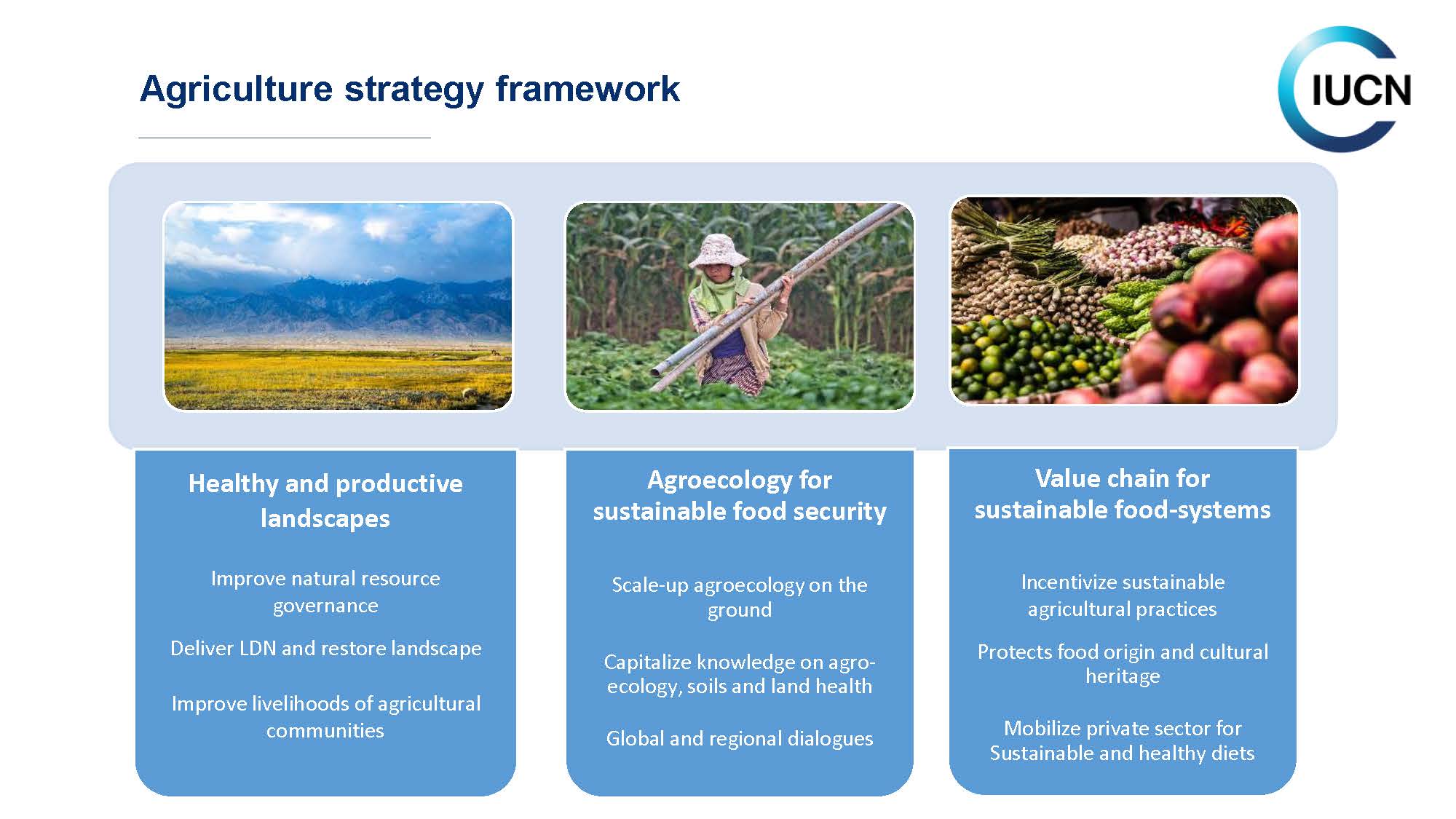
Heading 135+ Billion US$
increase in productivity if organic carbon in all the world’s agricultural soils were to increase by 0.4% annually
Heading every 5 seconds
a soccer pitch of soil is degraded

Heading 1 gram of soil
contains billions of microorganisms: bacteria, fungi, algae and protozoa
Our diverse and broad range of expertise and experience
- IUCN has an expansive and growing portfolio of agriculture projects with over CHF 190 million currently in the concept stage.
- IUCN has a wide range of implementation of agricultural approaches across regions primarily in Asia and Africa.
- IUCN has experience with a diverse range of over 25 types of agricultural commodities, with an emphasis on maize and rice.
- IUCN works on agricultural approaches in over 10 different types of ecosystems with an emphasis on agro-ecosystems and forests.
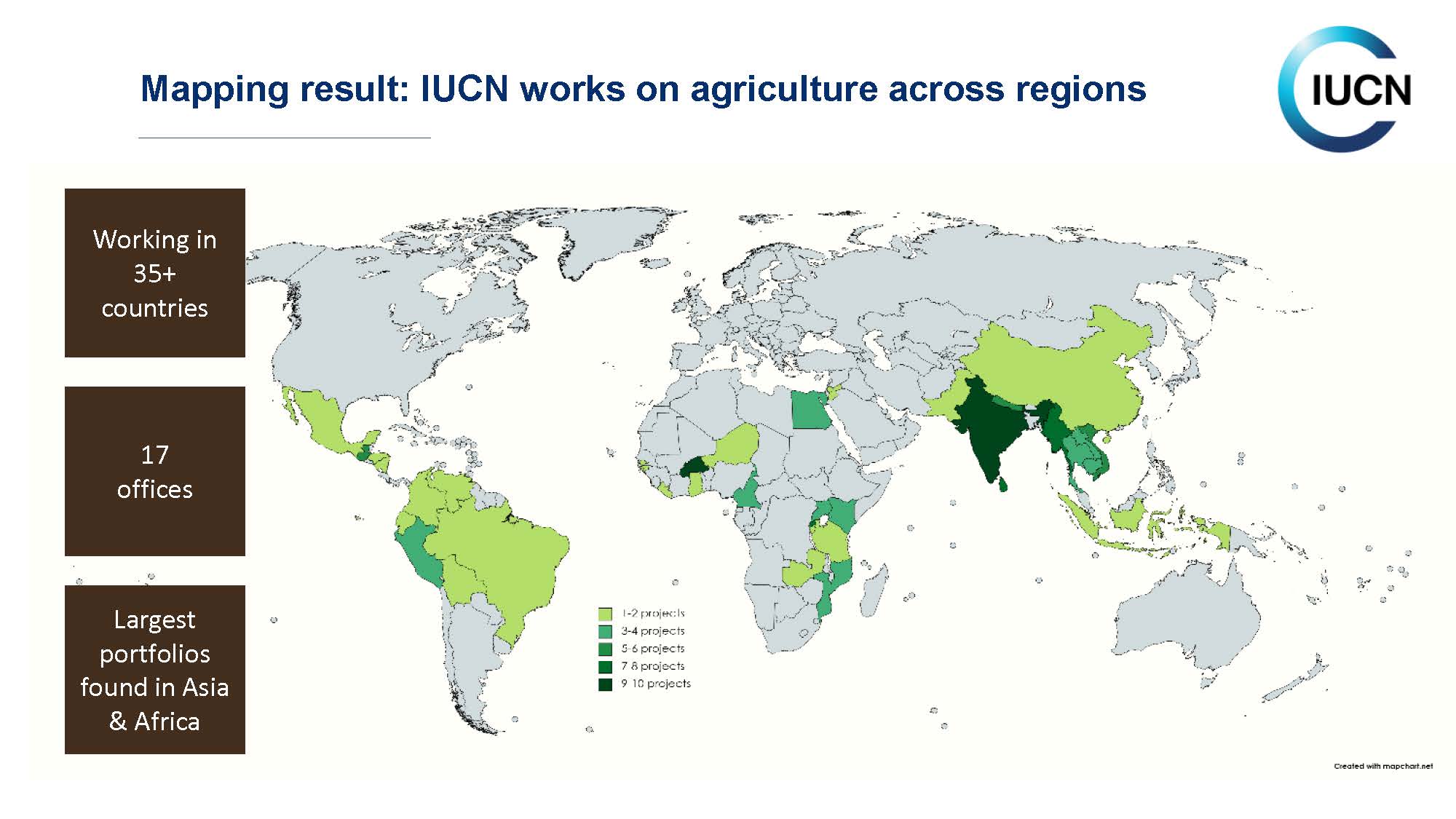
Linkages between agriculture and biodiversity
Instead of trying to understand agriculture in its own terms, acknowledge that agriculture ultimately comes out of nature. Right now agriculture is the No. 1 treat to biodiversity on the planet. – Wes Jackson, pioneer & researcher in natural systems agriculture and one of the foremost figures in the international sustainable agriculture movement
Issues around current farming methods
In recent decades, the agricultural sector has significantly increased productivity and drastically reduced the number of food insecure people worldwide, but with high costs to nature.
In many parts of the world, intensification and expansion of agriculture has degraded soils and ecosystems, depleted water sources and reduced biodiversity. As a result, farmers often have no choice but to search for new land to work or to use soil as a substrate with massive synthetic inputs.
Overuse of inputs is harming the long-term viability of farming, because it damages soils, reduces biodiversity and ultimately impairs our capacity to feed the world’s growing population. According to FAO, more than 25% of arable soils worldwide are degraded, and the equivalent of a soccer pitch of soil is eroded every five seconds.
Average yields have increased up to the 1990s, but have been stagnating and even decreasing in some parts of the world since.
Future demand for food will increase as the human population grows, and the environmental footprint of agriculture is expected to increase with it. This demand must be satisfied under changing climatic conditions, which will affect the quality and quantity of agricultural produce (Ebi and Loladze, 2019).
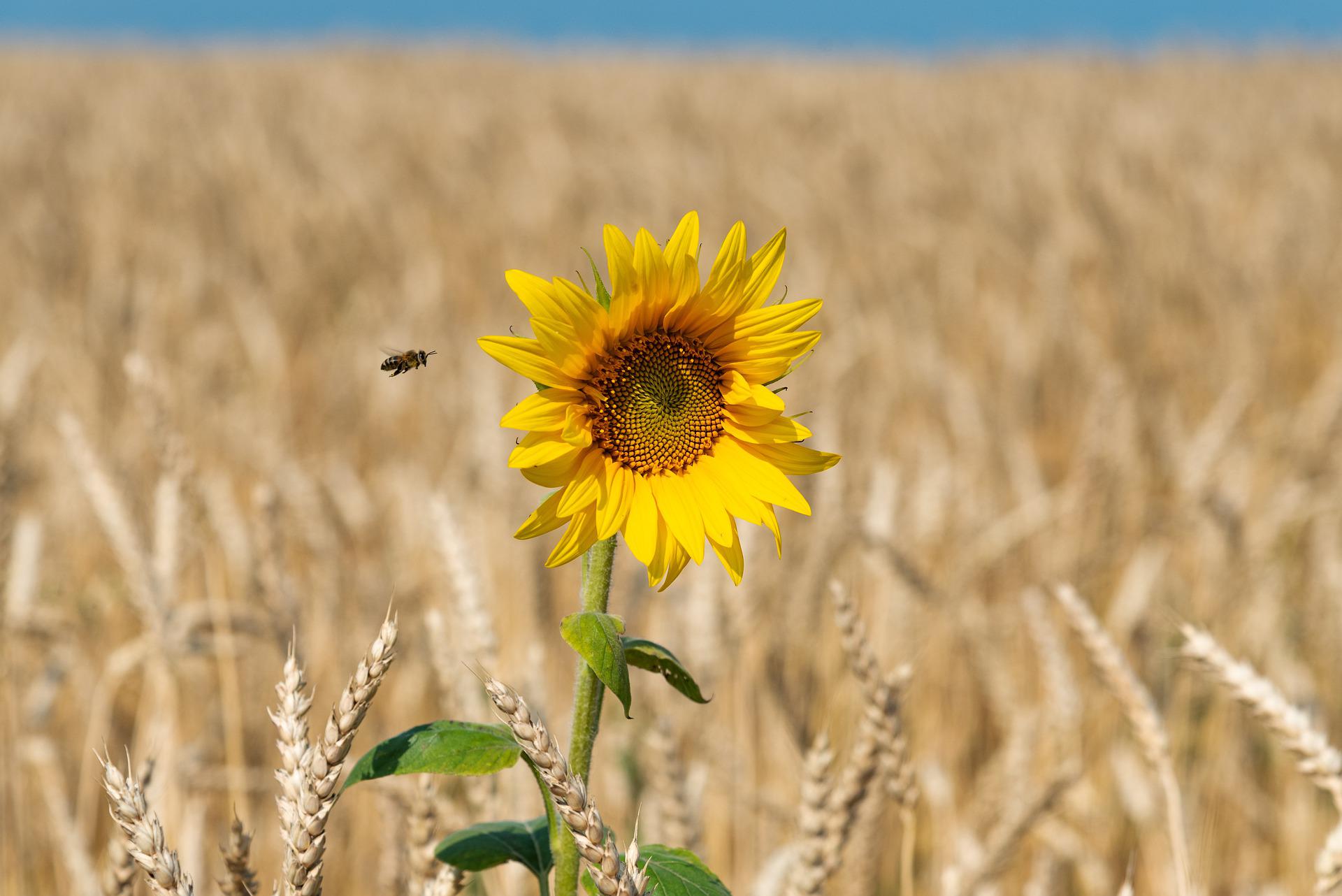
Most things, except agriculture, can wait.
Drivers towards a sustainable agriculture
Prioritise soil and landscape biodiversity for food and nature
Wide adoption of agro-ecological approaches for managing agricultural landscapes
Establish targets and indicators at national and global levels for sustainable agriculture
Reward farmers for ecosystem services provided through sustainable farming
Promote change throughout the global food system to enhance sustainability
Build consensus on environmental stewardship in the agricultural sector
Common Ground Dialogues
Following the common ground dialogues held at national levels in Rwanda and Tanzania, IUCN in East and Southern Africa Region (ESARO) with funding from IKEA Foundation is organising a Regional Common Ground Dialogue, on mainstreaming sustainable (encompassing agro-ecology and regenerative) agriculture in order to demonstrate how Nature-Based Solutions (NBS) can boost on-farm biodiversity, land productivity, conserve off-farm biodiversity in agricultural landscapes, and safeguard against habitat loss by maintaining long-term viability and productivity.
Regional Common Ground Dialogue for Mainstreaming Sustainable Agriculture in Eastern and Southern Africa
- Theme: Promoting Sustainable Farming Approaches for Conserving Biodiversity and Enhancing Food Production
- 17 - 18 October 2023
- Kampala, Uganda, Speke Resort Munyonyo
Regional Common Ground Dialogue to build consensus towards sustainable agriculture in Burkina Faso, Ghana and Niger
- 30 November - 1 December 2023
- Ouagadougou, Burkina Faso, IUCN-PACO
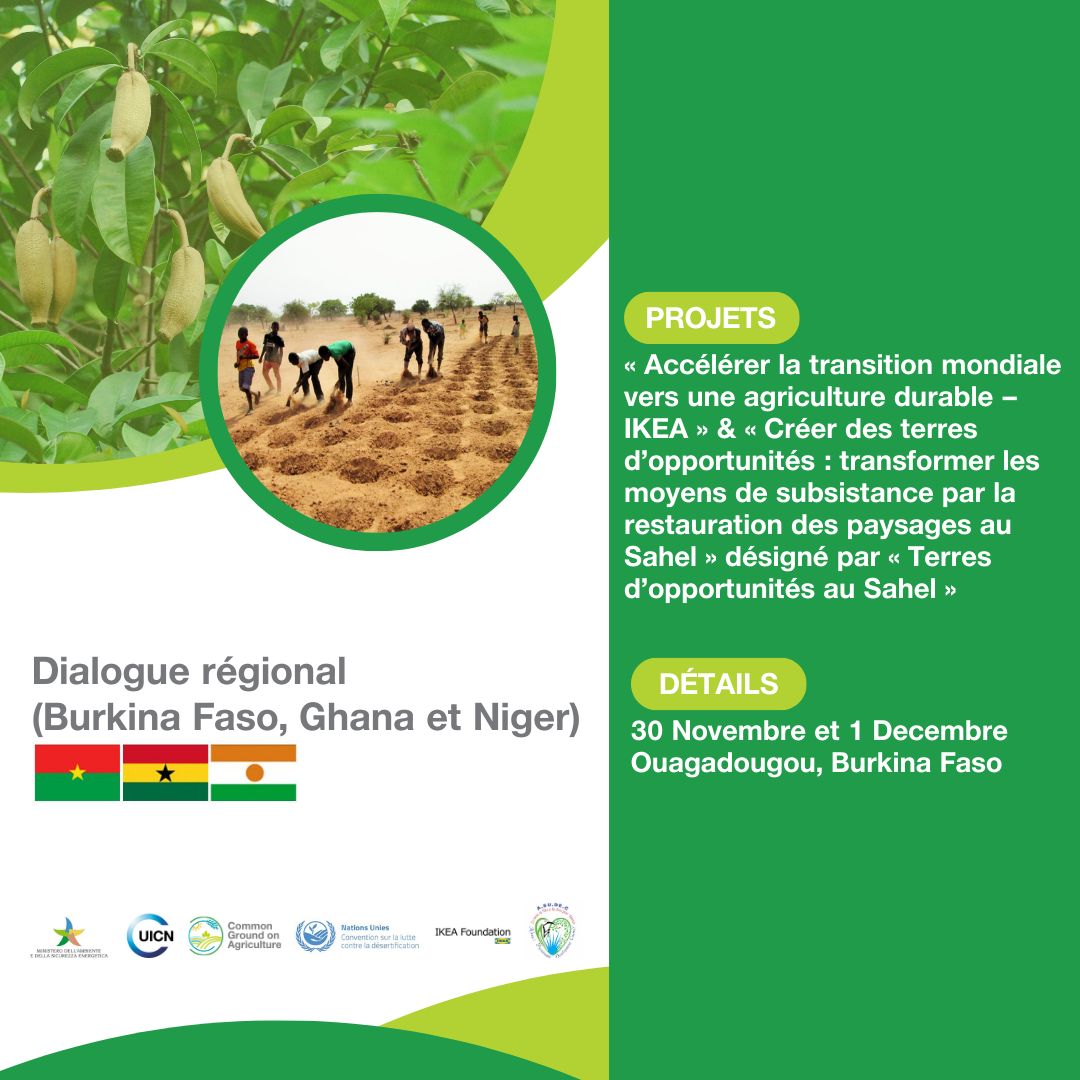
maintain healthy land to ensure sustainable agriculture and food security for an ever-growing population
(Dr Jacques SOMDA, Head of the IUCN Programme in Burkina Faso)
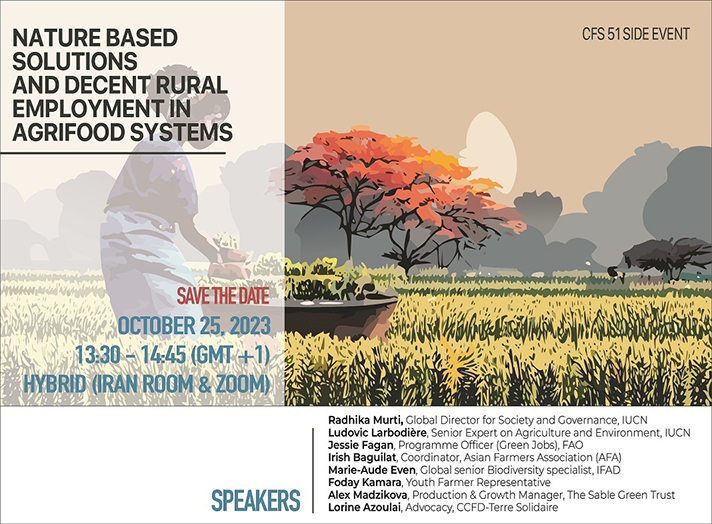
Topic search View
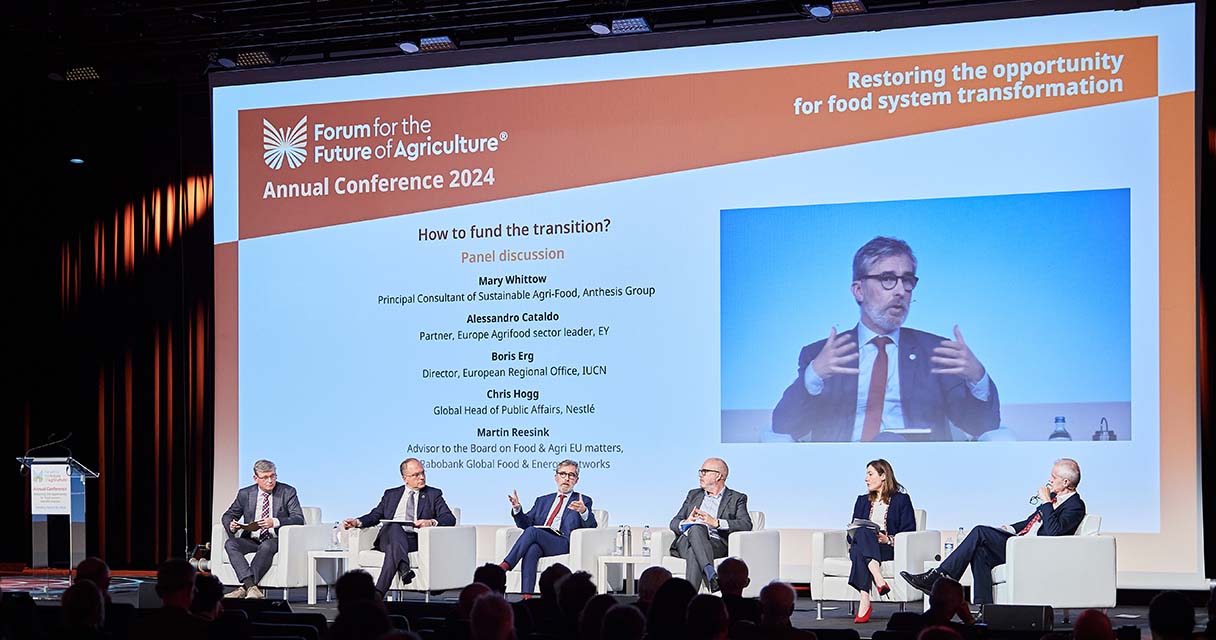
News | 29 Mar, 2024
Restoring the opportunity for food system transformation

Blog | 20 Mar, 2024
Global conference calls for urgent action to accelerate Nature-based Solutions to tackle global…

News | 20 Mar, 2024
PANORAMA launches revamped web platform to amplify solutions for a Healthier Planet
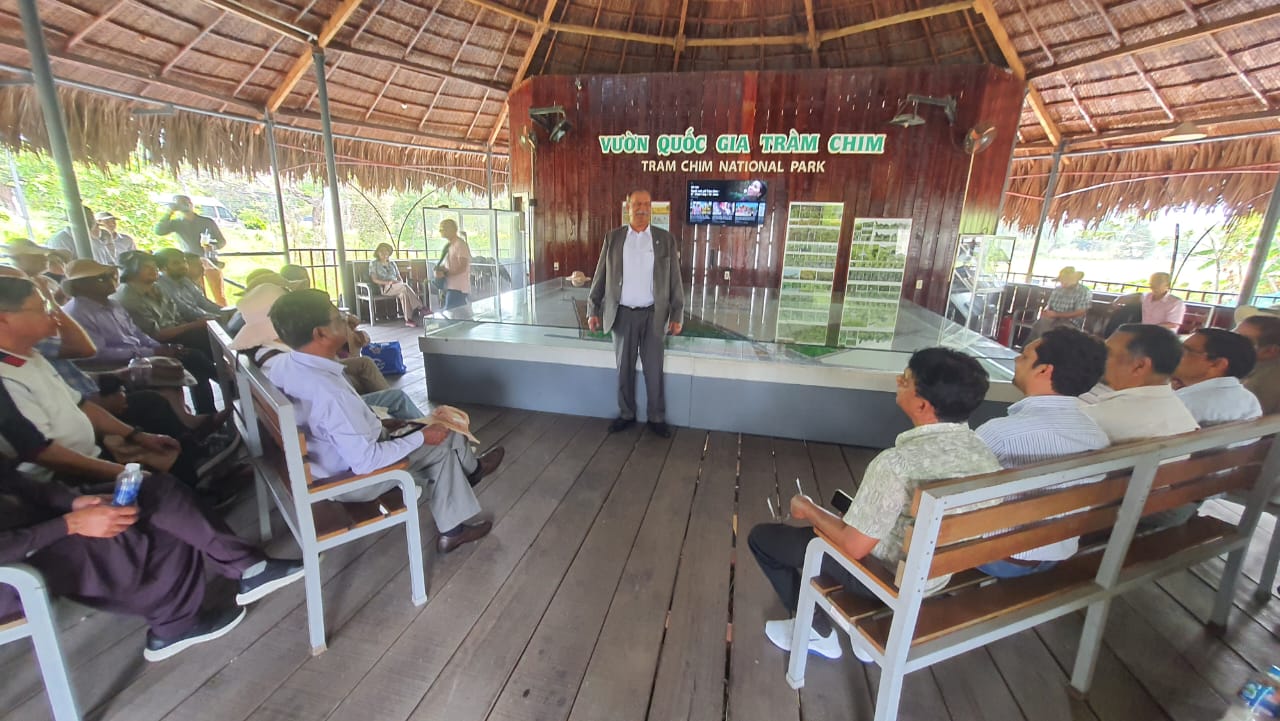
Story | 12 Mar, 2024
Beyond Borders: IUCN Pakistan's Impact at ACIAR Salinity Futures Symposium 2024
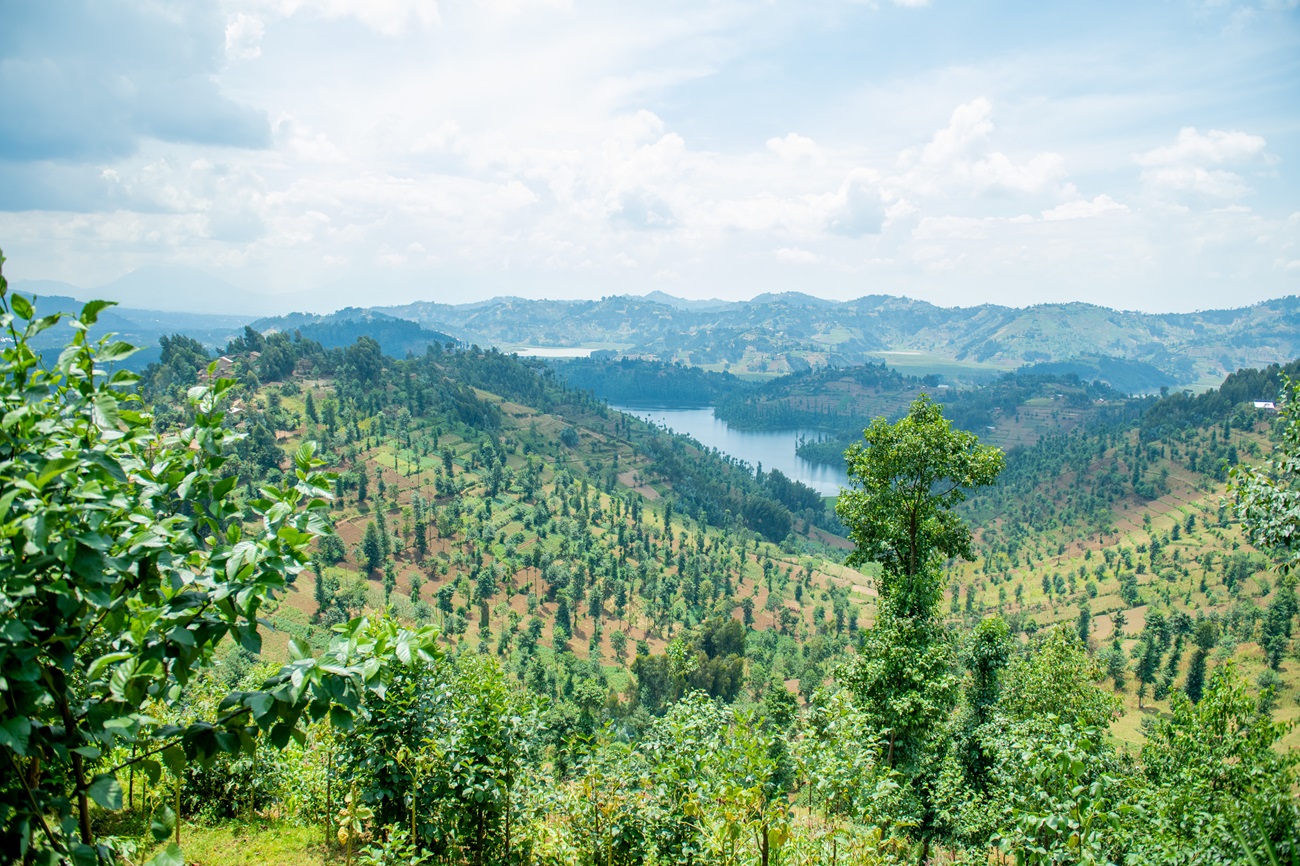
Story | 13 Feb, 2024
IUCN Rwanda Country Office knowledge products
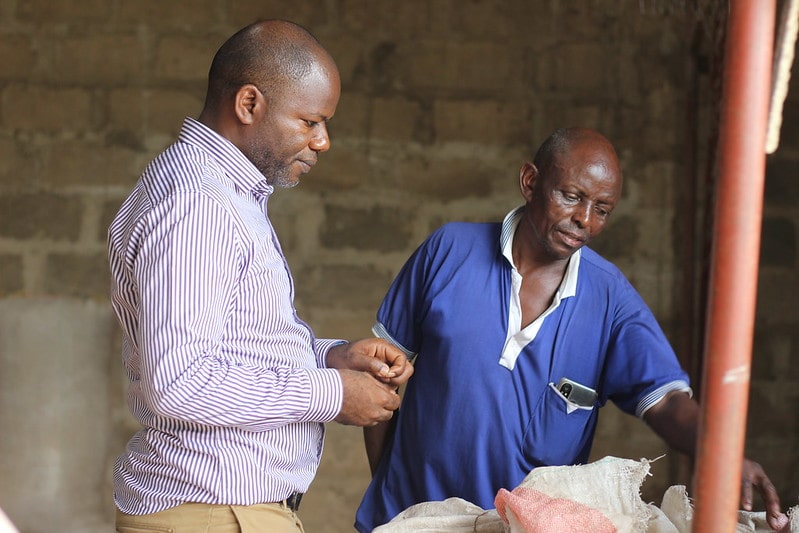
Story | 31 Jan, 2024
Kilombero farmers push for new path to sustainable agriculture

Sign up for an IUCN newsletter

121+ BEST AGRICULTURE ENGINEERING PROJECTS TOPICS
Final year projects for agricultural engineering.
121+ UNIQUE AGRICULTURE RELATED ENGINEERING PROJECTS | In this post we have shared Mechanical Agriculture Engineering Projects List And Reports. We, Mechanical farm , provide the widest list of mechanical engineering projects to help students, researchers & engineers in their R&D.
AGRICULTURE ENGINEERING PROJECTs TOPICS AND IDEAS:

We strive to provide our Viewers and Customers with the best service, so your feedback is very important to us. We would greatly appreciate it if you Would take a few minutes to share your experience on Google for us, we’d be so happy. To submit your review, simply click here and let us know what you think!
Category wise Mechanical Engineering Projects
- AGRICULTURE BASED PROJECT TOPICS
- ARTIFICIAL INTELLIGENCE PROJECTS TOPICS AND REPORTS
- PNEUMATIC AND HYDRAULIC PROJECTS
- AUTOMOBILE ENGINEERING PROJECT TOPICS, IDEAS, AND REPORTS
- SOLAR ENERGY PROJECTS FOR ENGINEERING STUDENTS
- DESIGN AND FABRICATION PROJECTS FOR MECHANICAL ENGINEERING
- JACK RELATED MECHANICAL ENGINEERING PROJECTS TOPICS AND REPORTS
Related Posts

{Updated} 51+ Low Cost Mini Projects for Mechanical Engineering Students

Rocker Bogie Project Report and Ppt
1 thought on “121+ best agriculture engineering projects topics”.
Thanks to you all for giving us this project but for me Iwant a project that can help us to grow crops in a small period of time using natural resources
Need any Project or any Help? Leave us a comment Cancel reply
Join our community.
- Share full article
Advertisement
Subscriber-only Newsletter
Unproductive Agriculture Is Holding Africa Back

By Peter Coy
Opinion Writer
Africa south of the Sahara is producing more than six times as much food as it did in 1961. That’s a much bigger increase than that of the world as a whole, which has merely quadrupled agricultural output, as this chart shows. From this data alone, sub-Saharan Africa seems to be an agricultural success story.
The next chart, though, gives a much darker picture. It shows sub-Saharan Africa badly trailing the world as a whole in improvements in total factor productivity of agriculture. Total factor productivity measures how much output increases over and above what one would expect from increased inputs of land, labor and machinery.
What these two charts tell us is that while Africa is increasing its output of crops, livestock and so on, it’s managing to do so only by massively increasing its inputs. That means many more farmers and much more land under cultivation or pasture. It’s better than if farm output hadn’t increased at all, but it’s not what the subcontinent needs to get ahead economically.
The classic story of economic development is that farmers become more efficient, which frees up their children to work in factories. The increase in factory output enriches the population, generating more demand for food. And the factories produce farm machinery that makes farmers even more efficient. Improvements in agriculture and industry reinforce each other in an upward spiral.
That’s not happening in sub-Saharan Africa. To understand why, I interviewed Enock Chikava, who grew up with 10 siblings on a small farm in Zimbabwe. “As a boy, I would spend long summers, from May to October, gathering crop debris and leaves from the nearby forest to mix into the soil as fertilizer,” he recalled in a 2021 article for the Gates Foundation, where he is the interim director of agricultural development.
Chikava, who went on to get an education in agricultural economics and business strategy, says economic growth in the agricultural sector is more than twice as effective at reducing poverty as is growth in other sectors.
Improving African farmers’ productivity requires three things, Chikava told me: innovation, extension (which means introducing innovations to farmers) and market incentives.
There’s progress on all three fronts. Cassava, for example, is a staple food in much of Africa and is hardy against drought. New varieties, called Baba 70 and Game Changer, can more than quadruple yields per hectare on small farms in Nigeria when cultivated with good agronomic practices and weed control, Chikava said. As for extension, countries are informing farmers digitally because they can’t afford to put enough extension officers in the field. On market incentives, sub-Saharan nations are using a mixture of price supports and subsidies for inputs such as fertilizer. That may offend pure free-marketers, and isn’t the best permanent solution, but often it’s the only way to keep farmers from quitting because they can’t make a living, Chikava said.
Tech companies are springing up to help. One example is Releaf, an agricultural technology company based in Lagos, Nigeria, that supplies palm oil to food companies. It’s using geospatial mapping and other technologies to locate small processing facilities closer to palm nut farmers, who can’t afford to ship the nuts long distances.
There’s a long way to go, though. Another reason for low productivity is that under the land tenure system that’s common in much of Africa, people keep the land only if they keep using it. So some farmers are doing just enough to maintain their claims, Kate Schecter, the president of World Neighbors, a U.S.-based charity that operates in 14 countries, including six in Africa, told me. In Burkina Faso, for example, World Neighbors’ country director told her that landowners “don’t necessarily learn very much about how to use the farm,” Schecter said. “It’s underexploited.”
Christopher Udry, an economics professor at Northwestern University, taught secondary school in Ghana while serving in the Peace Corps in the 1980s. He was struck by the missed economic opportunities. Children who spoke four languages dropped out after elementary school because they couldn’t make it to the nearest junior secondary school. “Once you meet people like that, it’s hard to think of anything else,” he said in a recent interview with Yale University, where he earned his doctorate.
Confirming what Chikava and Schecter told me, Udry said that agricultural yields are declining the most in the places where farmers have the most opportunities to do something else with their time. The more that opportunities in cities multiply, the more farmers are drawn away from the land.
The farmers are better off than if they didn’t have those outside options. “But it’s not the great productivity spiral that we did see in, say, American history,” Udry said. For sub-Saharan Africa to advance economically, fixing its farming must be a top priority.
Outlook: Deutsche Bank
There will be “a fire hose of Fedspeak and a deluge of important data” this week, economists at Deutsche Bank wrote in a client note last week. They pointed to speeches by Federal Reserve Chair Jerome Powell and other Fed officials as well as to major economic releases, including the March jobs report. The economists predict that Powell will continue to say on Wednesday that there’s no hurry about cutting rates, and that the Bureau of Labor Statistics will report on Friday that the U.S. economy added 200,000 nonfarm payroll jobs in March, down from the 275,000 that was reported for February.
Quote of the Day
“What other people label or might try to call failure I have learned is just God’s way of pointing you in a new direction.”
— Oprah Winfrey, in a commencement speech at Howard University ( May 12, 2007 )
Peter Coy is a writer for the Opinion section of The Times, covering economics and business. Email him at [email protected] . @ petercoy
Language selection
- Français fr
Government of Canada announces support for innovative solutions to address labour challenges in the agriculture and agri-food sector
From: Agriculture and Agri-Food Canada
News release
Today, Élisabeth Brière, Member of Parliament for Sherbrooke and Parliamentary Secretary to the Minister of Families, Children and Social Development and to the Minister of Mental Health and Addictions and Associate Minister of Health, on behalf of the Honourable Lawrence MacAulay, Minister of Agriculture and Agri-Food, announced the 5 projects that will receive up to $1 million in funding each under Phase 2 of the Innovative Solutions Canada (ISC) program – Challenge Stream. The announcement was made at Exonetik Inc., one of the Phase 2 winners.
April 5, 2024 – Sherbrooke, Quebec – Agriculture and Agri-Food Canada
The 5 projects, approved for funding by Agriculture and Agri-Food Canada, will target the Canadian meat processing industry and the Canadian controlled environment agriculture industry with the goal of advancing automation and robotic technologies. These companies have developed ideas to address challenges such as work productivity, labour shortages, and operational efficiency.
Under the Canadian Meat Processing Technology Development Challenge, projects include:
- Exonetik Inc. - Developing a low-cost, collaborative robot to help automate tasks
- E.O.I Technologies Inc. - Developing sensors to collect data on fast moving conveyor systems
Under the Enhancing Automation in Controlled Environment Agriculture (CEA) Farming Challenge, projects include:
- Exonetik Inc. – Developing a robotic arm to work alongside humans to harvest fruits and vegetables
- Mycionics Inc. – Developing a robotic mushroom harvester, packer and harvester lift
- Kinova Inc. – Developing a robotic arm to pick, harvest and de-leaf cucumbers and strawberries
"These cutting-edge solutions will help the sector overcome some of the challenges it faces, leading to a more prosperous and competitive future for Canadian agriculture. Congratulations to all of the winners and thank you for your great work.” - The Honourable Lawrence MacAulay, Minister of Agriculture and Agri-Food
“Through the Innovative Solutions Canada program, our government empowers SMEs to drive innovation and solve challenges. These initiatives support the sustainable growth of our economy and the agricultural industry.” - The Honourable François-Philippe Champagne, Minister of Innovation, Science and Industry
“Innovation is vital to address the challenges faced by producers and processors, such as labor shortages and improving conditions in greenhouses and slaughterhouses. Our government supports these efforts through Innovative Solutions Canada, assisting small and medium-sized Canadian businesses in developing new inventions that are crucial for the sector. I am proud of these advancements that support our food processors and farmers, highlighting the importance and essence of their work.” - Élisabeth Brière, Member of Parliament for Sherbrooke and Parliamentary Secretary to the Minister of Families, Children and Social Development and to the Minister of Mental Health and Addictions and Associate Minister of Health
"At Exonetik, our team is developing solutions that will enable our partners, Savoura and Frontmatec, to automate tasks that until now could only be performed by humans. With the support of Innovative Solutions Canada, we will complete the development of the first marketable version of teleoperable haptic robot arms, capable of learning from human operators and automatically reproducing the same operations, with a sensitivity and adaptability unattainable by industrial or collaborative robots. Our mission is to make the impossible possible, and we believe that robotics can solve the labor shortage problems facing companies in the agri-food sector." - Pascal Larose, Chief Executive Officer and co-founder of Exonetik
“Food processing facilities suffer from operational inefficiencies when it comes to running tens or hundreds of conveyor systems across a typical plant. Food safety and contamination are a constant concern, as well as costly downtime which must be minimized. We are developing an innovative sensing technology that can proactively monitor the health and condition of conveyor systems in real time and provide predictive intelligence in order to avoid failures and potential food contamination. We are grateful to the Innovative Solutions Canada Program and Agriculture and Agri-Food Canada for their support to develop a market ready solution which we can pioneer in Canada.” - Alex Sulkin, Chief Executive Officer and Founder of E.O.I Technologies
“Our exceptional team of Mycionics engineers is developing custom machine vision and robotic harvesting solutions to assist farmers with the increasing labor shortage in the global mushroom industry. Financial support from ICS will accelerate our technology development and enable the commercialization of this innovative Canadian technology.” - Michael Curry, Chief Executive Officer of Mycionics Inc.
"Kinova is delighted to have been selected to continue advancing robotics and automation in agriculture. With the first phase completed and the results positive, we are confident of the benefits for the second phase. We would like to thank Agriculture and Agri-Food Canada and Innovative Solutions Canada for their confidence.” - Jonathan Lussier, Director of Industrial Business Development for Kinova
Quick facts
Meat processing plants rely heavily on manual labour, and are challenging environments, cold with high humidity levels to manage effectively. Technical innovation provides opportunities to improve the operational efficiency and safety of workers in meat processing facilities where people and machines often interact.
Controlled Environmental Agriculture (CEA) production is labour intensive, requiring workers for a range of critical production tasks including propagation, planting, movement and management of plants, cleaning, harvesting, pest management, pruning, sorting and packaging. The greenhouse industry is by far the largest and fastest growing segment of indoor farming.
Related products
- Backgrounder: Supporting innovative solutions to address labour challenges
- Government of Canada invests in innovation and technology to tackle challenges in agriculture – Canada.ca
Associated links
- Innovation, Science and Economic Development Canada
- Agriculture and Agri-Food Canada
- Innovative Solutions Canada
- Exonetik Inc
- EOI Technologies Inc
Francis Chechile Press Secretary Office of the Minister of Agriculture and Agri-Food [email protected]
Media Relations Agriculture and Agri-Food Canada Ottawa, Ontario 613-773-7972 1-866-345-7972 [email protected] Follow us on Twitter , Facebook , Instagram , and LinkedIn Web: Agriculture and Agri-Food Canada
Page details

An official website of the United States government
Here’s how you know
Official websites use .gov A .gov website belongs to an official government organization in the United States.
Secure .gov websites use HTTPS A lock ( Lock A locked padlock ) or https:// means you’ve safely connected to the .gov website. Share sensitive information only on official, secure websites.
JavaScript appears to be disabled on this computer. Please click here to see any active alerts .
Newsletter: East Palestine Train Derailment Response, 4-4-2024
Newsletter serving Serving East Palestine, Negley, Darlington, and surrounding communities
Progress Made
- Project Spotlight
Agriculture Update
- Community Corner
- Newsletter Distribution
- About this Publication
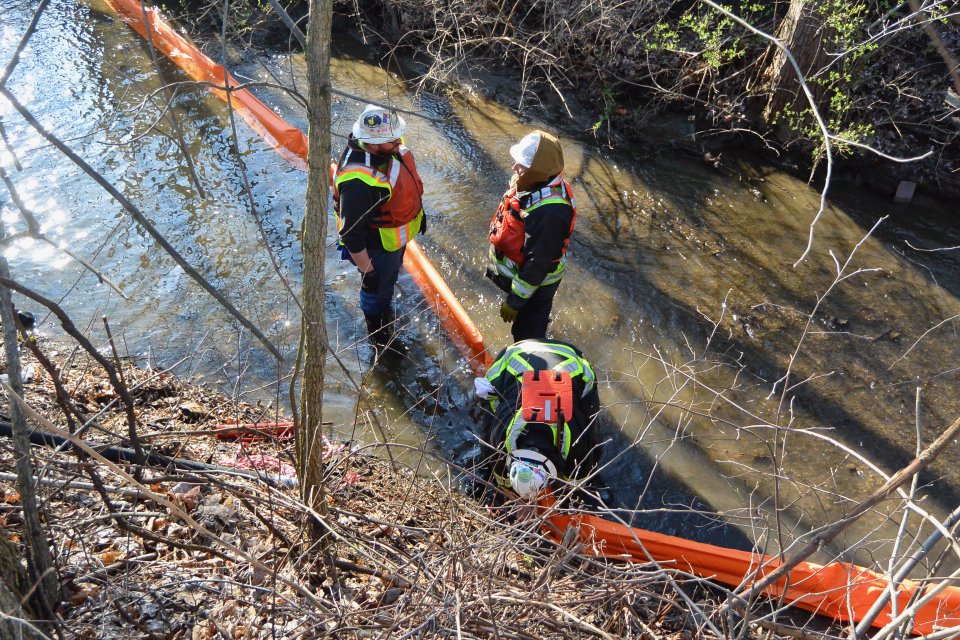
Final Culvert Cleanout
Cleanup activities, including sediment removal, began in the remaining culvert that starts underneath Liberty Street. The cleaning targets specific areas where oil sheen was observed during the assessment completed in December 2023. A high-powered vacuum hose is used to remove sediments inside the metal pipe section of the culvert. A control point is installed at the downstream end of the work area to contain and capture any released sheen that is not captured by the vacuum operation. This is the only culvert left to be addressed as four were previously cleaned last year. As of April 5, work has not resumed due to heavy rains and high water levels.
Stream Cleaning Operations
On March 25, Norfolk Southern began sediment cleanup in Sulphur Run. EPA later directed Norfolk Southern to suspend cleanup operations and evaluate how to more effectively contain and recover sheen from sediments. Once EPA approves an improved operational approach by Norfolk Southern, stream cleaning will resume. It’s expected that stream and culvert cleaning will both resume during the week of April 8 as long as water levels in the creeks are not too high.
Water Treatment Plant
Operations at the on-site wastewater treatment plant are reduced to sediment filtering capabilities only. As of March 14, water has been mostly disposed of as nonhazardous (without treatment) after testing shows it doesn’t contain site contaminants. This change reflects the success of the cleanup.
Update on Final Confirmation Sampling
Final confirmation sampling – the “double-check” to make sure hazardous substances are cleaned up to meet long-term cleanup standards – is approximately 57% complete. Details about this work can be found online in the Appendix E workplan. Sampling will look for any remaining soil contamination that may present a long-term risk from the spilled materials. The plan applies to a large industrial area and includes properties that were impacted directly and potentially by the derailment and cleanup efforts. If any soil that is sampled shows an exceedance of the screening level, it triggers an evaluation of the area to define the geographic extent of the exceedance. Then, assessment of that area will determine if more action is necessary. Of roughly 1,900 soil samples for volatile organic compounds taken so far, only about 1% have had low-level exceedances of the screening level for any chemical. This continues to confirm initial removal work was effective.
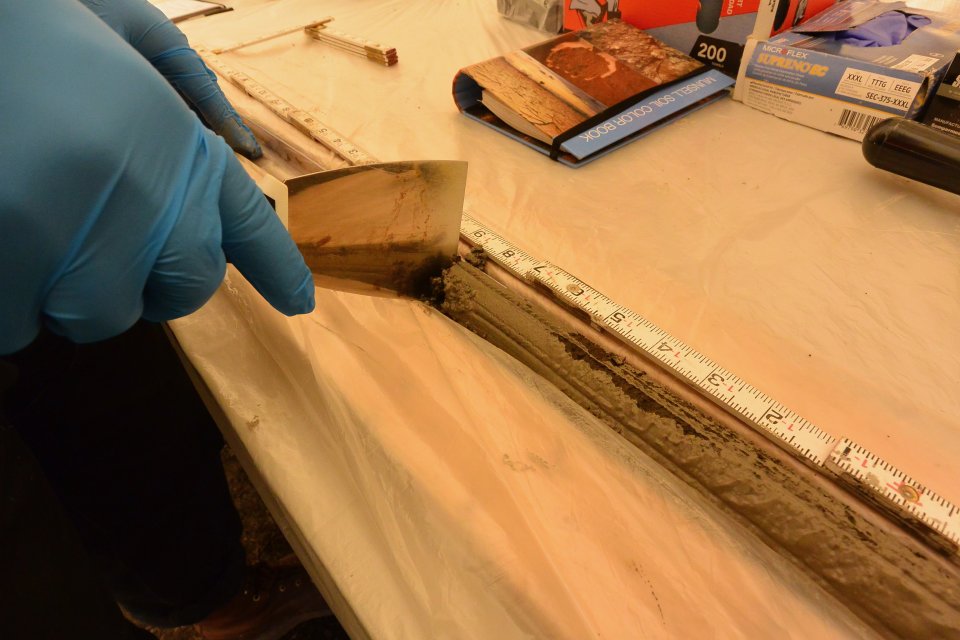
Project Spotlight: ACE Survey Follow-up
Residents and first responders who took the Assessment of Chemical Exposure (ACE) survey can take a follow up survey to report any changes that may have occurred. The follow-up survey includes questions about participants’ ongoing health symptoms, medical care received, and outstanding health concerns and needs. The survey will be available until April 30.
Ohio residents will be contacted by the Columbiana County Health District via email, if provided, or phone. If you didn’t get a chance to take the survey the first time, you can use the following link to record your initial responses: East Palestine 2024 New responses ACE Community Survey
Pennsylvania residents can access the survey for community members at Follow-up Assessment of Chemical Exposure (ACE) Community Survey [HD002491] , or for first responders at Follow-up Assessment of Chemical Exposure (ACE) First Responder Survey [HD002489] . To take the survey in-person, you can visit the Darlington Township Municipal Building on April 9, 18 or 25 from 4-8 p.m. or April 10, 19 or 26 from 10 a.m. to 2 p.m.
In April 2023, the Ohio Department of Agriculture and The Ohio State University conducted plant tissue sampling of crops in East Palestine and did not find contamination with semi-volatile organic compounds (SVOCs). Thirty-one samples were collected within a 5-mile radius of the derailment, and included tissue from winter wheat, malting barley, pasture grasses, rye, and forage covers. In 2023, Columbiana County crop producers saw yields above historical averages, consistent with trends in surrounding counties and statewide. For sampling results and maps visit Testing & Results . For 2023 crop stats visit: Ohio County Crop Estimates
Community Corner: Research Consortium
On April 10 from 6 to 7:30 p.m., the Ohio/Pennsylvania University Research Consortium will host a science update at The Way Station in East Palestine. The meeting will explore the scope and limits of publicly available data collected after the train derailment, including what’s been learned about air, plant, and water exposures, and a summary of the health issues and symptoms reported following the derailment. The Consortium is made up of researchers from seven universities, the East Palestine health community, and responding agencies with the goal of providing accurate, data-driven information. RSVP online .
Community Corner: Well Sampling Funding for Columbiana County
Funding for the residential well sampling project was secured in the recent federal budget and will help ensure residential well water in Columbiana County is safe to drink where municipal water is not available. The Columbiana County Health District has been sampling residential wells as part of the derailment response since April 2023. The local health department will share more information as it becomes available.
Newsletter Distribution Update
The next newsletter will be issued as notable reportable items become available. Stay updated on response activities by checking EPA’s response webpage .
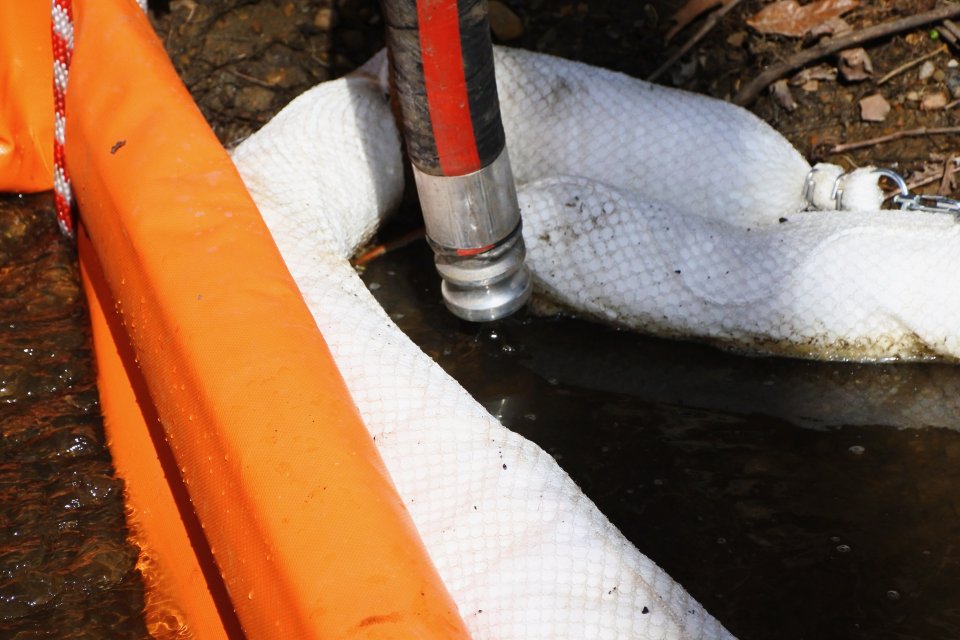

IMAGES
VIDEO
COMMENTS
List of 100 agriculture project topics. We compiled a list of 100 new agriculture project topics you can work on, check them out. Sustainable Crop Rotation Strategies for Enhanced Soil Health. Impact of Climate Change on Crop Yields: A Regional Analysis. Precision Agriculture: Integrating Technology for Farm Management.
Find out how to do agriculture projects for students on various topics, such as vertical farming, hydroponics, organic farming, and more. Learn the benefits, challenges, and methods of each project and get practical skills for your future career.
The United Nations projects that by 2050 the world population will have risen to 9.7 billion people—more than 2 billion more people than today! To feed everyone, we will need a lot more food, which makes agricultural technology incredibly important. Agricultural technology is the use of science, engineering, and technology to make agriculture ...
WASHINGTON, Oct. 6, 2021 - U.S. Department of Agriculture (USDA) Secretary Tom Vilsack announced today an investment of more than $146 million in sustainable agricultural research projects aimed at improving a robust, resilient, climate-smart food and agricultural system.. This investment is made under the National Institute of Food and Agriculture's (NIFA) Sustainable Agricultural Systems ...
The term ''sustainable agriculture'' ( U.S. Code Title 7, Section 3103) means an integrated system of plant and animal production practices having a site-specific application that will over the long-term: Satisfy human food and fiber needs. Enhance environmental quality and the natural resource base upon which the agriculture economy depends.
WASHINGTON, September 29, 2021 - Agriculture Secretary Tom Vilsack today announced a comprehensive set of investments to address challenges facing America's agricultural producers. These include assistance to address challenges and costs associated with drought, animal health, market disruptions for agricultural commodities, and school food supply chain issues.
Agricultural Development. Our goal. To support farmers and governments in sub-Saharan Africa and South Asia that are seeking a sustainable, inclusive agricultural transformation—one that creates economic opportunity, respects limits on natural resources, and gives everyone equal access to affordable, nutritious food. Our strategy.
In Angola, the Angola Commercial Agriculture Development Project , co-financed by the World Bank and the French Agency for Development, contributed to the government economic diversification agenda by supporting the transition from subsistence to a more market-oriented, competitive agriculture sector.The project helping producers or small and medium enterprises prepare and finance agriculture ...
The project has six components, including building resilient agricultural production capacity to strengthen the productivity and resilience of domestic food production to shocks and stressors, by supporting the development and adoption of improved agricultural inputs and services and climate-smart and gender-sensitive farming technologies in ...
5 Key Issues in Agriculture in 2021. As 2021 ends, we take a retrospective look at five topics that were covered in our analytical work this year. These issues represent just a fragment of the Bank's work, but they are key to reducing poverty and hunger while slowing climate change. Food Security.
The U.S. Department of Agriculture (USDA) is accepting project proposals now through July 2, 2024, that will help farmers, ranchers, and forest landowners adopt and expand conservation strategies to enhance natural resources while tackling the climate crisis. These projects in turn can save farmers money, create new revenue streams, and ...
Sustainable agriculture is a dynamic practice that encompasses technology and farming methods to preserve natural resources and ensure their viability for years to come. Some commonly used sustainable agriculture practices include: Increased crop diversity: This allows farmers to profit from high yields of multiple crops year round, limit ...
Climate-smart agriculture (CSA) has grown from a concept into an approach implemented throughout the world, by all types of stakeholders. This publication describes climate-smart agriculture case studies that apply the five action points for CSA implementation. The action points are: 1) expanding the evidence base for CSA, 2) supporting ...
WASHINGTON, Sept. 19, 2022 - The U.S. Department of Agriculture's Foreign Agricultural Service is awarding $300,000 to six U.S. universities - including three minority-serving institutions - for research and educational partnerships focused on climate-smart agriculture in tropical countries, FAS Administrator Daniel Whitley announced today.
Project partners plan to build on the support of government policies that require certain institutions to include fresh food in their meal plans and another that mandates nonprofit hospitals ...
The United Nations projects that by 2050 the world population will have risen to 9.7 billion people—more than 2 billion more people than today! To feed everyone, we will need a lot more food, which makes agricultural technology incredibly important. Agricultural technology is the use of science, engineering, and technology to make agriculture ...
Paper Roller Coasters - Fun STEM Activity! Science projects and lesson plans to explore concepts in agriculture technology - innovations to help improve farming practices and feed the world. Explore classic and cutting-edge high school science experiments in this collection of top-quality science investigations.
The Agriculture Project's objectives are to increase rural incomes and stimulate the rural economy through rural entrepreneurship. To achieve these objectives, the project focuses on improving factor productivity and competitiveness of agricultural products by providing assistance for the: a) privatization of rural lands; b) privatization and ...
Supported in part by funding from USDA's National Institute of Food and Agriculture as well as funding from other federal agencies, the University of Maryland College of Agriculture and Natural Resources' (AGNR) research and Extension programs take a comprehensive, multi-disciplinary approach to that challenge. "Climate smart agricultural practices that reduce environmental impact while ...
The 2023 project will focus on distributional impacts, because USDA is also committed to promoting equitable outcomes both in the impact of climate-related changes and in the design of policy responses. Doing so requires analysis and measurement of the effects of climate change in the agricultural sector on different groups in the population.
Agriculture is a vital human activity that deeply impacts, but also deeply relies on nature. Agriculture is expected to cover an increasing world food, feed, fiber and fuel demand for 8.5 billion people in 2030. The shift to more sustainable production systems and agricultural practices is therefore critical to conserve nature and achieve more sustainable and resilient societies.
There are many exciting project ideas at Science Buddies for students interested in agriculture, plant, and food science. Whether students want to explore questions related to plant growth or strategies for crops and farmland, these hands-on science projects may required additional time and planning. In our guest post on the American Farm ...
The project therefore is aimed at enhancing food security and farmer's participation in environmental conservation for sustainable production during our lifetime and for the future generations. 3.0 Problem Statement Since the introduction of the scientific agriculture, farmers and consumers have lacked
AGRICULTURE BASED ENGINEERING PROJECT IDEAS . 1. Solar Powered Tea Leaf Cutting Machine. 2. Plant watering automation. 3. Monitor and control your irrigation system with a mobile app. 4. Wireless soil moisture probe with helium and df robot.
80. By Peter Coy. Opinion Writer. Africa south of the Sahara is producing more than six times as much food as it did in 1961. That's a much bigger increase than that of the world as a whole ...
The 5 projects, approved for funding by Agriculture and Agri-Food Canada, will target the Canadian meat processing industry and the Canadian controlled environment agriculture industry with the goal of advancing automation and robotic technologies. These companies have developed ideas to address challenges such as work productivity, labour ...
Storm Surge Activity - Protect Houses From Waves. Science projects and lesson plans to explore concepts in agriculture technology - innovations to help improve farming practices and feed the world. Try your hand at building cool devices and exploring amazing reactions with these sixth grade science experiments.
Agriculture Update. In April 2023, the Ohio Department of Agriculture and The Ohio State University conducted plant tissue sampling of crops in East Palestine and did not find contamination with semi-volatile organic compounds (SVOCs). ... Funding for the residential well sampling project was secured in the recent federal budget and will help ...
Dear Chair Durfee and members of the House Agricultural Committee, As you consider energy and land use policy, I encourage you to read the testimony filed in the 20 MW Shaftsbury Solar case, which you can find here: ... the Public Utility Commission's ability to evaluate projects. Shaftsbury Solar is the perfect example of a renewable energy ...
Science projects and lesson plans to explore concepts in agriculture technology - innovations to help improve farming practices and feed the world. Explore cool phenomena and build fun devices with science experiments hand-picked for eight grade students.